Module 11 Body language(共52张PPT)
文档属性
| 名称 | Module 11 Body language(共52张PPT) | 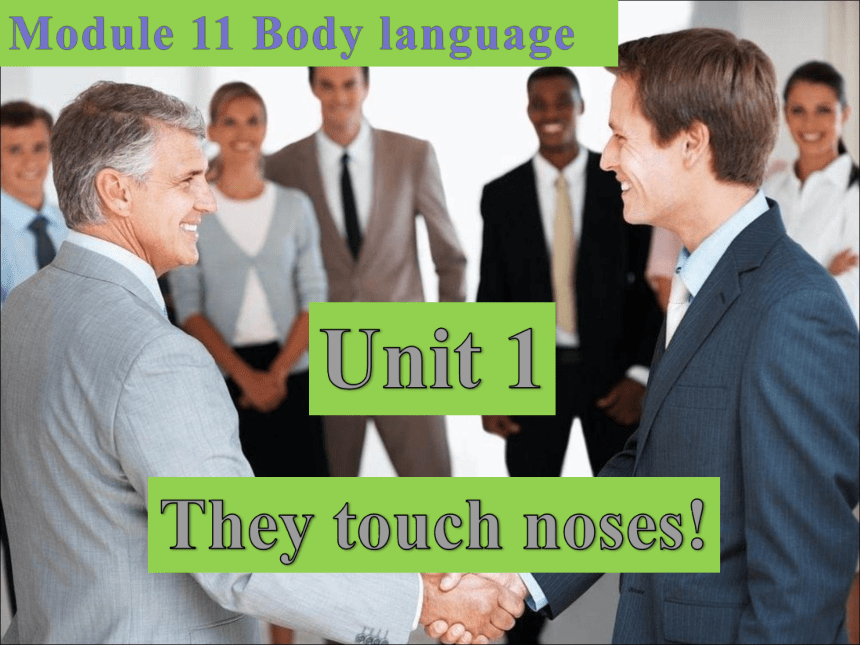 | |
| 格式 | ppt | ||
| 文件大小 | 4.2MB | ||
| 资源类型 | 教案 | ||
| 版本资源 | 外研版 | ||
| 科目 | 英语 | ||
| 更新时间 | 2022-06-27 09:21:02 | ||
图片预览

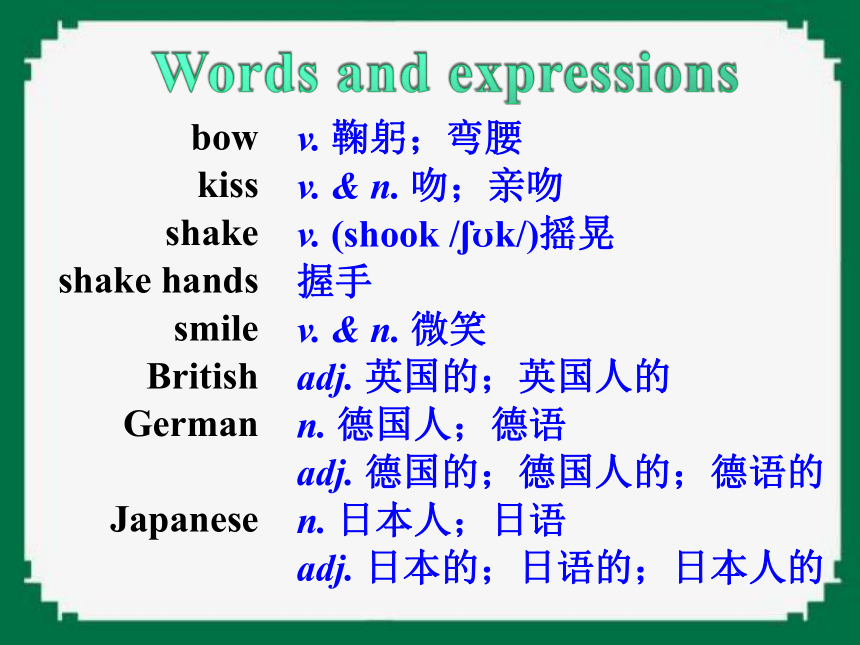
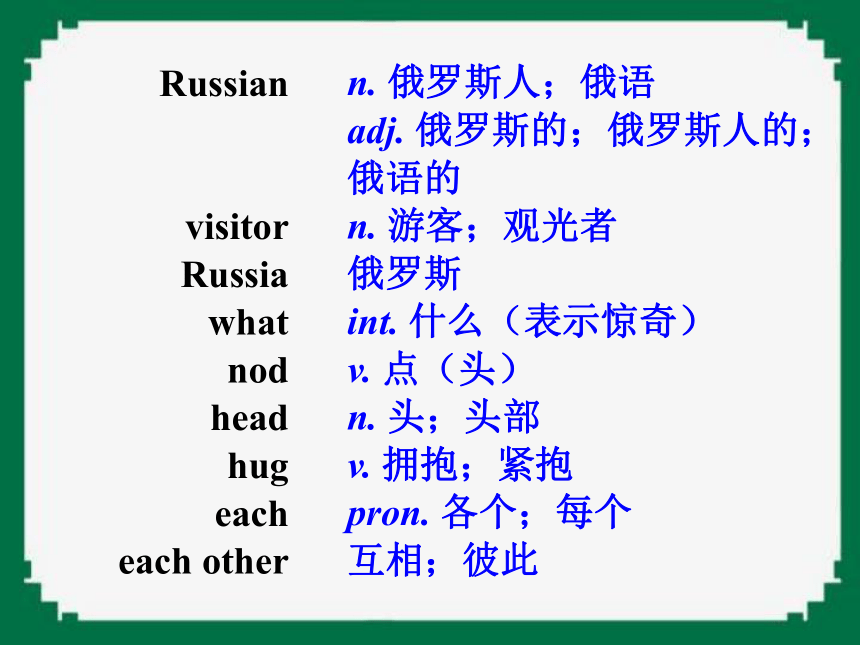
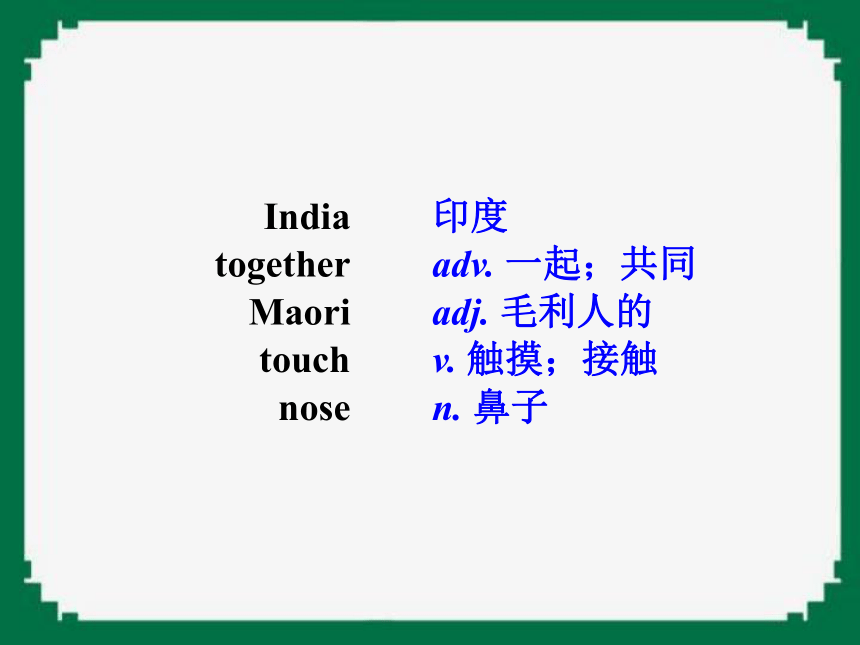
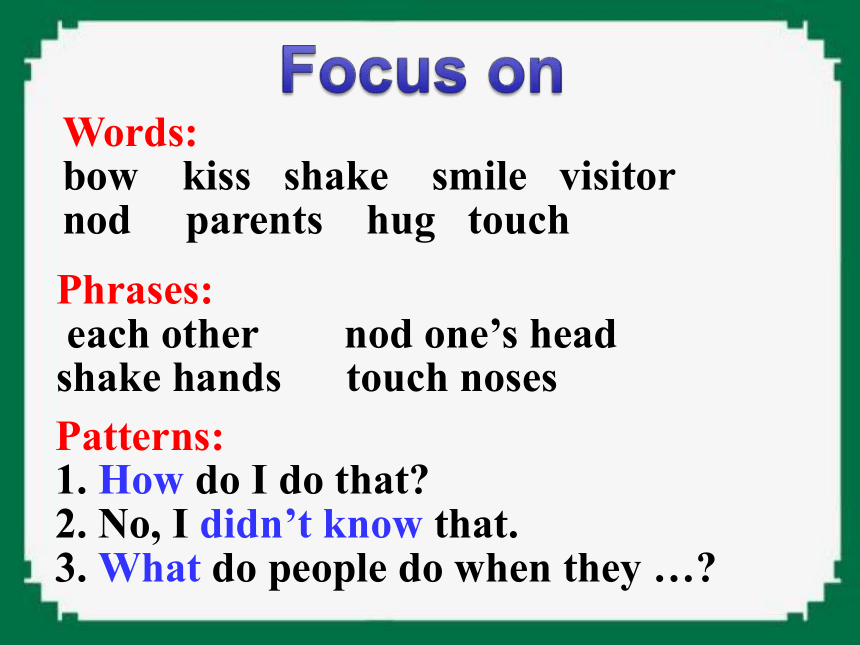
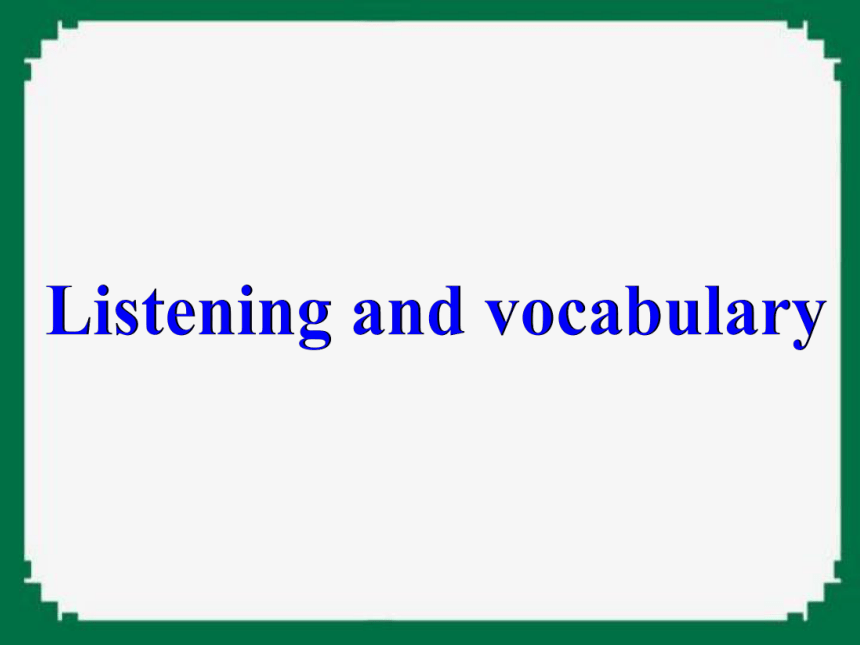
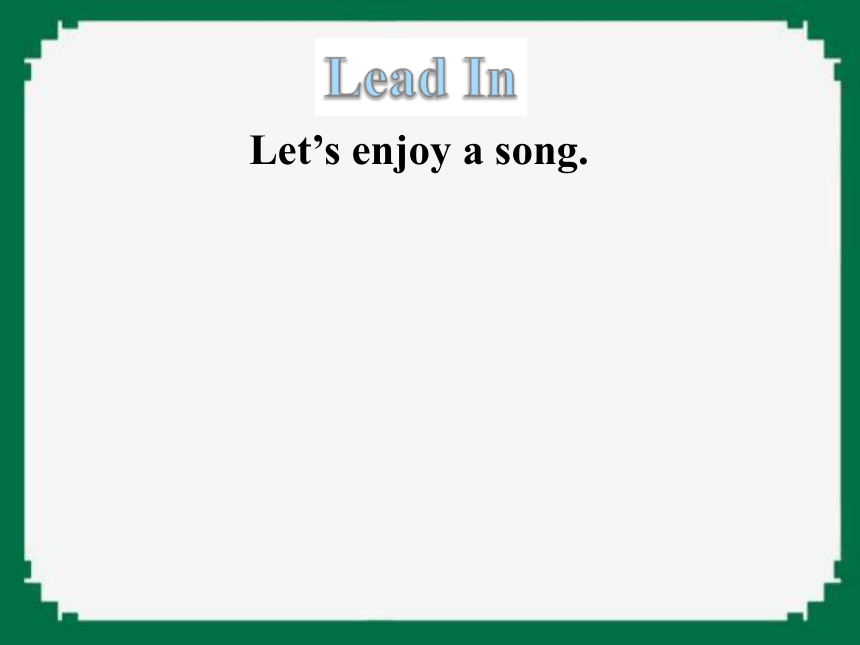
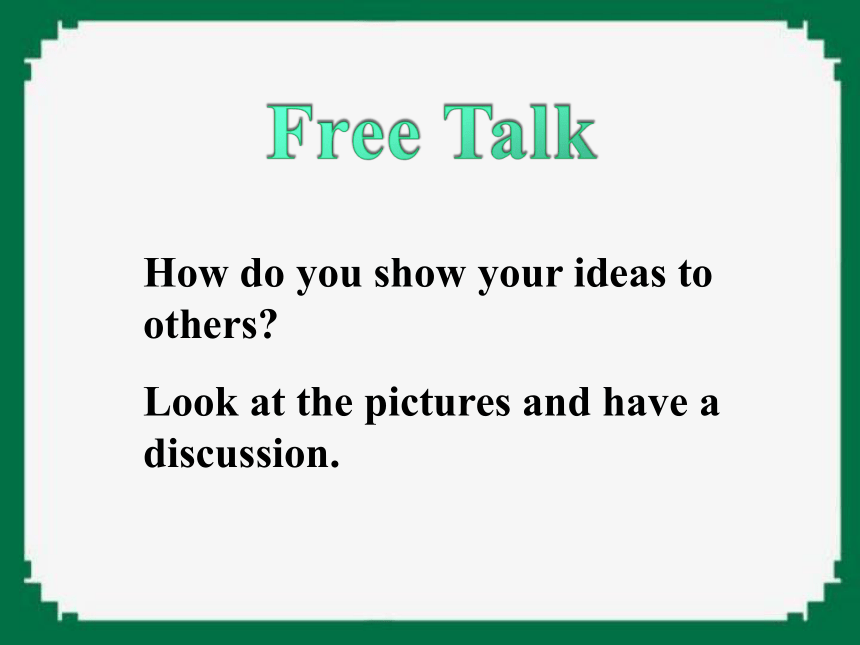
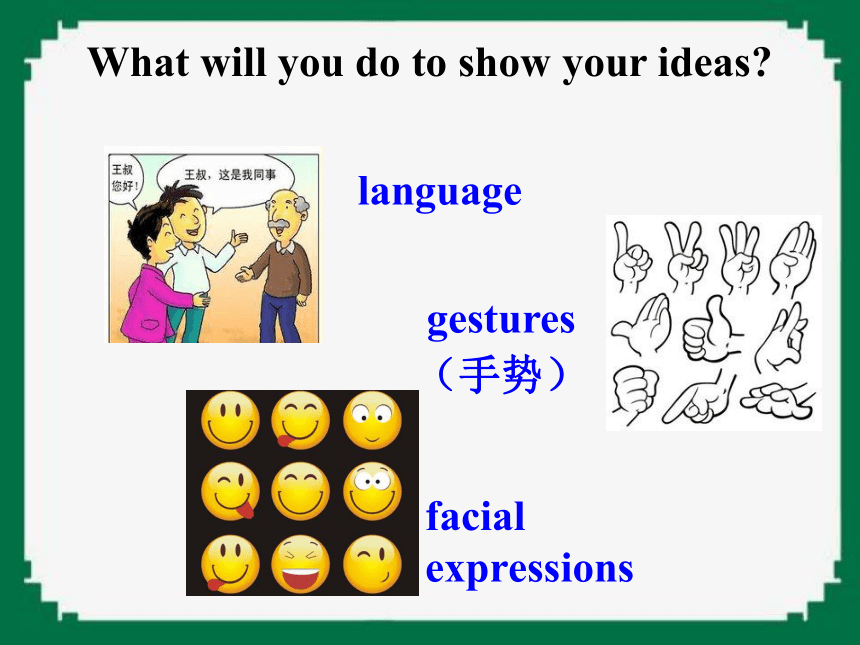
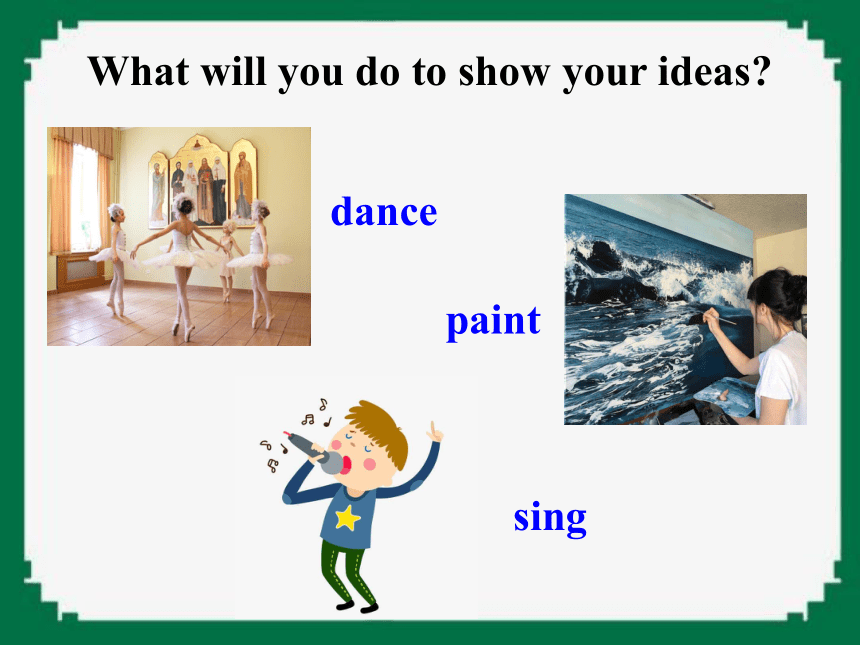
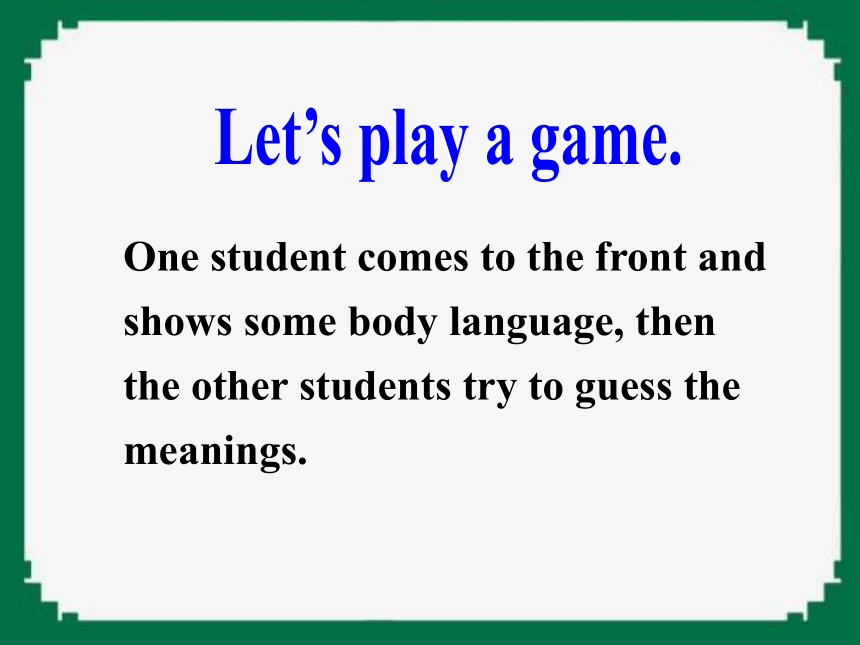
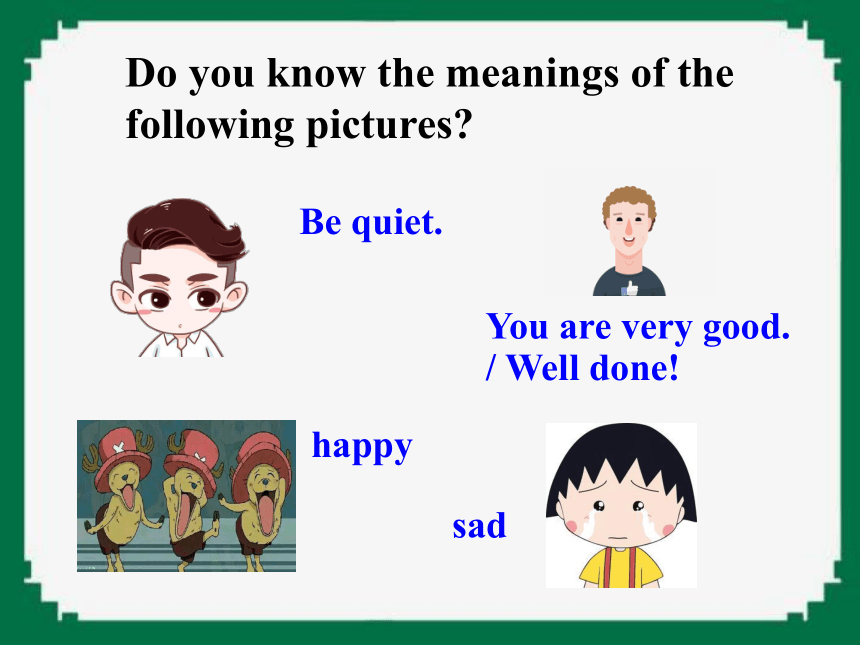
文档简介
(共52张PPT)
v. 鞠躬;弯腰
v. & n. 吻;亲吻
v. (shook / k/)摇晃
握手
v. & n. 微笑
adj. 英国的;英国人的
n. 德国人;德语
adj. 德国的;德国人的;德语的
n. 日本人;日语
adj. 日本的;日语的;日本人的
bow
kiss
shake
shake hands
smile
British
German
Japanese
n. 俄罗斯人;俄语
adj. 俄罗斯的;俄罗斯人的;俄语的
n. 游客;观光者
俄罗斯
int. 什么(表示惊奇)
v. 点(头)
n. 头;头部
v. 拥抱;紧抱
pron. 各个;每个
互相;彼此
Russian
visitor
Russia
what
nod
head
hug
each
each other
印度
adv. 一起;共同
adj. 毛利人的
v. 触摸;接触
n. 鼻子
India
together
Maori
touch
nose
Words:
bow kiss shake smile visitor nod parents hug touch
Phrases:
each other nod one’s head shake hands touch noses
Patterns:
1. How do I do that
2. No, I didn’t know that.
3. What do people do when they …
Let’s enjoy a song.
How do you show your ideas to others
Look at the pictures and have a discussion.
What will you do to show your ideas
language
gestures
(手势)
facial expressions
What will you do to show your ideas
sing
paint
dance
One student comes to the front and shows some body language, then the other students try to guess the meanings.
Be quiet.
Do you know the meanings of the following pictures
You are very good.
/ Well done!
sad
happy
It’s OK.
say “ yes”
angry
tired
Do you know the meanings of the following pictures
Do you know how to say hello
Do you know their differences between Chinese and foreigners
Look at the pictures and have a discussion.
Chinese way
Shake hands and smile
Russian way
Kiss three times
American way
Shake hands, kiss or hug
Indian way
Put hands together and nod heads.
Maori people
Touch noses
1. Match the pictures with the words and expression from the box.
bow kiss shake hands smile
1
2
3
1
2
3
1 / 2 / 3
P66
Do you remember …
nation people
China
Chinese
British
Britain
Japan
Japanese
French
France
Russia
Russian
Germany
German
Australia
Australian
the US
American
Canada
Canadian
2. Listen and match the pictures with the nationality.
British French
German Japanese
Russian
1
3
2
P66
Tapescript:
Daming: What are they doing
Betty: They are saying hello. They’re kissing.
Daming: Are they German Or British
Betty: Maybe they’re French.
Daming: And these people are shaking
hands. I think they’re Russian.
Betty: I think so too. And these
people are Japanese, I think.
Daming: Why
Betty: Because they’re smiling at
each other and bowing.
Work in pairs and check.
— Are they Russian
— Yes, they are.
— What are they doing
— They’re shaking hands.
Ask and answer.
— Are they Japanese
— Yes, they are.
— What are they doing
— They’re bowing.
P66
Who will come to Lingling’s school
Some Russian teachers.
2. Which country’s people do they talk about in the conversation
Russia, China, the US, India and New Zealand.
Listen and answer the questions.
1. What’s Lingling going to do
She is going to welcome some Russian teachers.
2. Do the Russian and American people greet each other in the same way
No, they don’t.
Read and check the sentences.
1. People in Russia usually kiss the visitors three times, right, left, right.
2. Chinese often shake hands and smile when they meet visitors.
3. Chinese never kiss the visitors.
4. People in the US shake hands, and some kiss or hug each other.
5. People put their hands together and nod their heads in India.
6. Maori people touch noses when they meet.
×
√
√
√
√
√
1. What do people in Russia do when they meet
2. What do Chinese do when we meet visitors
Read and answer the questions about the dialogue.
People in Russia usually kiss three times, left, right, left.
Chinese often shake hands and smile when we meet visitors.
In the US some people shake hands, and some kiss or hug each other.
They touch noses.
3. What do people in the US usually do when they meet
4. What do Maori people do when they meet
India kiss Russia together touch visitor
Read and complete the table with the correct form of the words from the box.
In China, people shake hands and smile
when they meet ________.
American people shake hands and sometimes ______
In ______, people put their hands ___________ and nod their heads
In ______, people kiss each other three times
Maori people _______ noses
India
Russia
visitors
touch
together
kiss
P67
What!
I don’t know that!
什么!(表示吃惊)
我不知道啊!
A: Come to school at 6:40
tomorrow morning.
B: What! So early!
A: Last night I met with
Mary in the party.
B: Was she there I didn’t
know that.
4. Listen and repeat.
Chinese each French teacher touch
British shake
people
French
British
/t /
/ /
/pl/
/fr/
/br/
P67
[t∫]发这个音的字母和字母组合ch tch
ch: teacher peach cherry chair
tch: watch match
[∫] 发这个音的字母和字母组合s sh
s: sugar sure
sh: ship sheep wash cash shop she
Work in groups. Talk about what you do and say when you meet:
your teacher
your head teacher
your parents after school
your best friend
your best friend’s parents
your favourite film star
a visitor to your school
an American
a Russian
— What do you do and say when you meet your teacher in the morning
— I smile and say good morning.
P67
How do you express “I want to eat”, “I’m full” and “I’m hungry” with your body language
Try to use your body to act out the following actions!
Stop!
You are very good.
It’s OK.
Bye-bye.
总结回顾
1. How do I do that
2. People usually kiss three times.
3. Chinese often shake hands and smile when we …
4. They touch noses!
5. That’s because …
6. What do people do when they …
1. English-Chinese
German hug shake
2. Chinese-English
鞠躬 点(头)
英国的 触摸
游客 印度
1. Do you know what body language is
2. Do you know what people usually do in Russia when they meet
3. Can you talk about what you do and say when you meet a visitor to China
4. Can you show different body language in different countries to your class
I. 根据首字母及句子意思,填入恰当的词。
1. “Welcome!”, she s_____ hands and smiles.
2. She came and gave her grandpa a h___.
3. If you agree with my ideas, please n___ your head.
4. Maori people in New Zealand t_____ noses when they meet.
5. They b___ to their king every morning.
hakes
ug
od
ouch
ow
II. 根据今天所学内容,完成短文。
In ______, people shake hands and smile when they meet visitors. In _______________, people shake hands and sometimes kiss. In _____, people put their hands together and nod their heads. In ______, people usually kiss three times. In ____________, Maori people touch noses.
China
America / the US
India
Russia
New Zealand
Recite the conversation.
Write a short passage about the greeting ways in China.
v. 鞠躬;弯腰
v. & n. 吻;亲吻
v. (shook / k/)摇晃
握手
v. & n. 微笑
adj. 英国的;英国人的
n. 德国人;德语
adj. 德国的;德国人的;德语的
n. 日本人;日语
adj. 日本的;日语的;日本人的
bow
kiss
shake
shake hands
smile
British
German
Japanese
n. 俄罗斯人;俄语
adj. 俄罗斯的;俄罗斯人的;俄语的
n. 游客;观光者
俄罗斯
int. 什么(表示惊奇)
v. 点(头)
n. 头;头部
v. 拥抱;紧抱
pron. 各个;每个
互相;彼此
Russian
visitor
Russia
what
nod
head
hug
each
each other
印度
adv. 一起;共同
adj. 毛利人的
v. 触摸;接触
n. 鼻子
India
together
Maori
touch
nose
Words:
bow kiss shake smile visitor nod parents hug touch
Phrases:
each other nod one’s head shake hands touch noses
Patterns:
1. How do I do that
2. No, I didn’t know that.
3. What do people do when they …
Let’s enjoy a song.
How do you show your ideas to others
Look at the pictures and have a discussion.
What will you do to show your ideas
language
gestures
(手势)
facial expressions
What will you do to show your ideas
sing
paint
dance
One student comes to the front and shows some body language, then the other students try to guess the meanings.
Be quiet.
Do you know the meanings of the following pictures
You are very good.
/ Well done!
sad
happy
It’s OK.
say “ yes”
angry
tired
Do you know the meanings of the following pictures
Do you know how to say hello
Do you know their differences between Chinese and foreigners
Look at the pictures and have a discussion.
Chinese way
Shake hands and smile
Russian way
Kiss three times
American way
Shake hands, kiss or hug
Indian way
Put hands together and nod heads.
Maori people
Touch noses
1. Match the pictures with the words and expression from the box.
bow kiss shake hands smile
1
2
3
1
2
3
1 / 2 / 3
P66
Do you remember …
nation people
China
Chinese
British
Britain
Japan
Japanese
French
France
Russia
Russian
Germany
German
Australia
Australian
the US
American
Canada
Canadian
2. Listen and match the pictures with the nationality.
British French
German Japanese
Russian
1
3
2
P66
Tapescript:
Daming: What are they doing
Betty: They are saying hello. They’re kissing.
Daming: Are they German Or British
Betty: Maybe they’re French.
Daming: And these people are shaking
hands. I think they’re Russian.
Betty: I think so too. And these
people are Japanese, I think.
Daming: Why
Betty: Because they’re smiling at
each other and bowing.
Work in pairs and check.
— Are they Russian
— Yes, they are.
— What are they doing
— They’re shaking hands.
Ask and answer.
— Are they Japanese
— Yes, they are.
— What are they doing
— They’re bowing.
P66
Who will come to Lingling’s school
Some Russian teachers.
2. Which country’s people do they talk about in the conversation
Russia, China, the US, India and New Zealand.
Listen and answer the questions.
1. What’s Lingling going to do
She is going to welcome some Russian teachers.
2. Do the Russian and American people greet each other in the same way
No, they don’t.
Read and check the sentences.
1. People in Russia usually kiss the visitors three times, right, left, right.
2. Chinese often shake hands and smile when they meet visitors.
3. Chinese never kiss the visitors.
4. People in the US shake hands, and some kiss or hug each other.
5. People put their hands together and nod their heads in India.
6. Maori people touch noses when they meet.
×
√
√
√
√
√
1. What do people in Russia do when they meet
2. What do Chinese do when we meet visitors
Read and answer the questions about the dialogue.
People in Russia usually kiss three times, left, right, left.
Chinese often shake hands and smile when we meet visitors.
In the US some people shake hands, and some kiss or hug each other.
They touch noses.
3. What do people in the US usually do when they meet
4. What do Maori people do when they meet
India kiss Russia together touch visitor
Read and complete the table with the correct form of the words from the box.
In China, people shake hands and smile
when they meet ________.
American people shake hands and sometimes ______
In ______, people put their hands ___________ and nod their heads
In ______, people kiss each other three times
Maori people _______ noses
India
Russia
visitors
touch
together
kiss
P67
What!
I don’t know that!
什么!(表示吃惊)
我不知道啊!
A: Come to school at 6:40
tomorrow morning.
B: What! So early!
A: Last night I met with
Mary in the party.
B: Was she there I didn’t
know that.
4. Listen and repeat.
Chinese each French teacher touch
British shake
people
French
British
/t /
/ /
/pl/
/fr/
/br/
P67
[t∫]发这个音的字母和字母组合ch tch
ch: teacher peach cherry chair
tch: watch match
[∫] 发这个音的字母和字母组合s sh
s: sugar sure
sh: ship sheep wash cash shop she
Work in groups. Talk about what you do and say when you meet:
your teacher
your head teacher
your parents after school
your best friend
your best friend’s parents
your favourite film star
a visitor to your school
an American
a Russian
— What do you do and say when you meet your teacher in the morning
— I smile and say good morning.
P67
How do you express “I want to eat”, “I’m full” and “I’m hungry” with your body language
Try to use your body to act out the following actions!
Stop!
You are very good.
It’s OK.
Bye-bye.
总结回顾
1. How do I do that
2. People usually kiss three times.
3. Chinese often shake hands and smile when we …
4. They touch noses!
5. That’s because …
6. What do people do when they …
1. English-Chinese
German hug shake
2. Chinese-English
鞠躬 点(头)
英国的 触摸
游客 印度
1. Do you know what body language is
2. Do you know what people usually do in Russia when they meet
3. Can you talk about what you do and say when you meet a visitor to China
4. Can you show different body language in different countries to your class
I. 根据首字母及句子意思,填入恰当的词。
1. “Welcome!”, she s_____ hands and smiles.
2. She came and gave her grandpa a h___.
3. If you agree with my ideas, please n___ your head.
4. Maori people in New Zealand t_____ noses when they meet.
5. They b___ to their king every morning.
hakes
ug
od
ouch
ow
II. 根据今天所学内容,完成短文。
In ______, people shake hands and smile when they meet visitors. In _______________, people shake hands and sometimes kiss. In _____, people put their hands together and nod their heads. In ______, people usually kiss three times. In ____________, Maori people touch noses.
China
America / the US
India
Russia
New Zealand
Recite the conversation.
Write a short passage about the greeting ways in China.
同课章节目录
- Module 1 Lost and found
- Unit 1 Whose bag is this?
- Unit 2 Are they yours?
- Unit 3 Language in use
- Module 2 What can you do ?
- Unit 1 I can play the piano
- Unit 2 I can run really fast
- Unit 3 Language in use
- Module 3 Making plans
- Unit 1 What are you going to do at the weekends?
- Unit 2 We're going to cheer the players.
- Unit 3 Language in use
- Module 4 Life in the future
- Unit 1 Everyone will study at home
- Unit 2 Every family will have a small plane.
- Unit 3 Language in use
- Module 5 Shopping
- Unit 1 What can I do for you?
- Unit 2 You can buy everything on the Internet
- Unit 3 Language in use
- Module 6 Around town
- Unit 1 Could you tell me how to get to the Nationa
- Unit 2 The London Eye is on your right.
- Unit 3 Language in use
- Revision module A
- Module 7 My past life
- Unit 1 I was born in a small village.
- Unit 2 I was born in Quincy.
- Unit 3 Language in use
- Module 8 Story time
- Unit 1 Once upon a time….
- Unit 2 Goldilocks hurried out of the house.
- Unit 3 Language in use
- Module 9 Life history
- Unit 1 He left school and began work at the age of
- Unit 2 He decided to be an actor.
- Unit 3 Language in use
- Module 10 A holiday journey
- Unit 1 What did you do?
- Unit 2 This morning we took a walk.
- Unit 3 Language in use
- Module 11 Body language
- Unit 1 They touch noses!
- Unit 2 Here are some ways to welcome them.
- Unit 3 Language in use
- Module 12 Western music
- Unit 1 It's so beautiful!
- Unit 2 Vienna is the centre of European classical
- Unit 3 Language in use
- Revision module B
